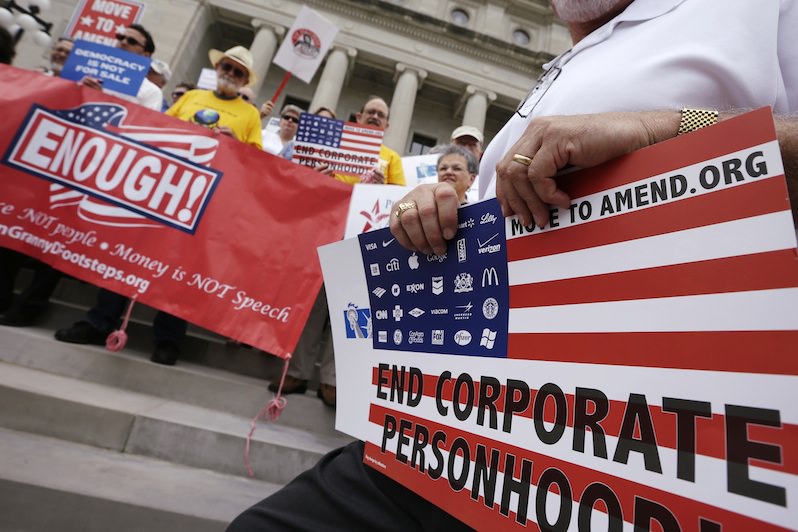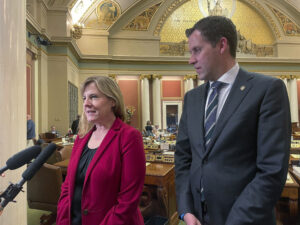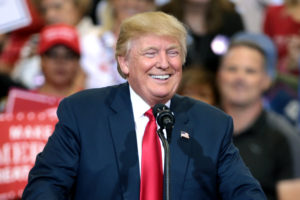The People vs. Citizens United: 7 Steps to Reversing Runaway Political Spending
The struggle against the corporate stranglehold on our democracy won’t be conducted in courtrooms or legislatures. It will arise from below, in organized, mass demands for change. Members of the Arkansas Democracy Coalition and other groups rally at the state Capitol in Little Rock in May. Speakers at the rally called for a constitutional amendment to overturn the U.S. Supreme Court's Citizens United ruling. (Danny Johnston / AP)
Members of the Arkansas Democracy Coalition and other groups rally at the state Capitol in Little Rock in May. Speakers at the rally called for a constitutional amendment to overturn the U.S. Supreme Court's Citizens United ruling. (Danny Johnston / AP)
This is the second of a two-part series on the Supreme Court’s Citizens United decision and efforts to counter its impact on political spending. Read the first installment here.
The March 2015 edition of the Harvard Law Review features an article that begins with the following (paraphrased) scenario: A presidential candidate walks on stage at a swanky fundraiser organized by a super PAC established to support his candidacy. He asks the assembled Gucci- and Prada-clad donors to pony up the official individual limit on political contributions (currently $5,400) in checks made out directly to the super PAC. He then leaves for another event.
After the candidate departs, a business leader working on behalf of the super PAC delivers a toast to the crowd, asking the donors to pledge $100,000 instead of the measly $5,400. The donors reach for their checkbooks—or better still, ask their aides to fetch them—and voila, they amplify the candidate’s request nearly 20-fold.
Even if you’ve studied the Citizens United opinion and are alarmed that the Supreme Court has overturned decades of federal election law and expanded the meme of money as speech, you still might think this scenario would violate the rules prohibiting “coordination” of fundraising activities between candidates and their super PACs. But you’d be wrong.
According to a 2011 advisory opinion released by the Federal Election Commission (FEC), the scenario would be perfectly legal. As long as the candidate, who cannot—following the reasoning of Citizens United—request money that exceeds the limits on contributions made directly to his campaign, anyone else not employed by the campaign can ask at the very same event for unlimited donations to the super PAC.
The super PAC can use the donations from such fundraisers to make unlimited “independent expenditures” on the candidate’s behalf. What’s more, to conduct its own business operations, the super PAC can hire many of the same vendors and service providers—political consultants, pollsters, ad buyers, even law firms—that work for the candidate. The super PAC can even accept donations from the candidate’s family.
The saddest part about the Harvard scenario, of course, is that it isn’t an interesting, hypothetical, law-school puzzler. In fact, such brazen and open coordination happens with increasing regularity, and it’s really just the tip of a political process that has degenerated into a structure of “legalized bribery” that has ceded campaign finance to corporations and the super-rich.
The fightback will be long, difficult and uncertain.
Like the Civil War in the 19th century, the struggle to reverse Citizens United and other aspects of our hijacked system in the 21st will be waged on hundreds of battlefields in hundreds of places, in skirmishes and confrontations small and large. It will take place in courtrooms and legislatures, in polling booths and in discussions in living rooms and over kitchen tables, in neighborhood and movement meetings, in social media and news outlets, and in demonstrations in the streets.
I don’t pretend to have all the answers or to be the originator of any of the suggestions that appear below. But here are some steps we should consider, starting with the minimal and immediate:
1. Reforming the FEC
Established in 1975, the FEC is an independent regulatory agency run by six commissioners, appointed by the president and confirmed by the Senate, who are responsible for the civil enforcement of campaign finance law. Candidates for federal office are required to file quarterly reports with the agency. Super PACs and traditional PACs (which in contrast to the “super” variety can contribute directly to candidates but are far more restricted as to how they can solicit donations) must report to the FEC on a monthly or quarterly basis.
But like the political activities it is supposed to oversee, the FEC is broken. Its own chairwoman has publicly admitted the agency is “worse than dysfunctional.” According to the Center for Responsive Politics, the FEC has never voted to begin a single investigation of alleged illegal campaign coordination.
The closest it has come to doing so apparently occurred in June of this year, when the it ordered the super PAC supporting Republican presidential hopeful Carly Fiorina to change its name because its title—Carly for America—was too closely associated with the name of the candidate. The super PAC complied, rebranding itself as CARLY, which it maintained was not a reference to the office-seeker but an acronym standing for Conservative, Authentic, Responsive Leadership for You and for America. Problem solved, case closed.
One small step toward reforming the FEC and encouraging it to undertake more enforcement actions would be for Congress to pass HR 2931, the bipartisan (believe it or not) Restoring Integrity in America’s Elections Act. The bill would reduce the number of commissioners to five (providing for more tie-breaking votes) and require that the fifth appointee have no ties with either Republicans or Democrats. Under present law, three commissioners may—and currently do—hail from the same party, a condition that has resulted in near-permanent stalemate.
2. Passing the Disclose Act
Among the serious threats to democracy in America today is the lack of transparency in elections caused by the rise of “dark money” organizations. Such groups, organized under section 501(c)(4) of the federal tax code, masquerade as “social welfare” nonprofits but nonetheless may legally spend untold millions on expressly political advertising. Under current law, they do not have to publicly disclose their donors. The Disclose Act has been kicking around Congress in one form or another since 2010. Its present iteration is SB 229.
To promote transparency and help anyone interested in understanding who (whether the Koch brothers, Sheldon Adelson, George Soros or any such billionaire) is responsible for piping all those annoying 30-second ads onto their TV screens each election season, the act would require all groups that spend more than $10,000 on political advocacy to identify their major contributors.
The Disclose Act is a small but straightforward measure, and the Citizens United case doesn’t stand in its way. In fact, the Citizens United decision speaks laudably about the benefits of campaign spending disclosure requirements, although the decision on its own did nothing to stem the dark-money tide.
3. Passing the Shareholder Protection Act and ending the legal double standard for corporations and unions
One of the more naive and laughable aspects of the Citizens United decision, however, was its discussion of shareholder rights. In his majority opinion, Justice Anthony Kennedy duly noted that some shareholders might be upset with the court’s decision to permit corporations to use general treasury funds—which shareholders may think of as their own money—for campaign spending without their consent. But he concluded that any shareholders who disapproved of business decisions to buy election ads could settle their disputes by means of the tried and true procedures of “corporate democracy.” Corporations, in other words, could be trusted.
Labor unions, of course, have been shown no such solicitude by the Supreme Court under the leadership of Chief Justice John Roberts. Under current federal law, workers in bargaining units who choose not to become formal union members, but nonetheless benefit from union contracts, may request a refund of any fees collected from them that are used to pay for political activities. In some situations, the Roberts court even has said that unions must obtain prior written consent from nonunion workers before receiving any fees from them.
The Shareholders Protection Act, currently pending as HR 446, would restore a small semblance of balance between labor and capital as well as a modicum of “corporate democracy.” If passed, it would require corporations to hold a separate shareholder vote before disbursing general corporate treasury funds in excess of $50,000 to support or oppose federal candidates.
4. Expanding public funding of elections
Getting money out of politics, or at least reducing its role, will require a vast enlargement of state and federal public campaign financing programs. Although the Supreme Court in 2011 invalidated an Arizona provision that expanded the public matching funds available to state candidates who squared off against wealthy opponents, the court has long held that public funding generally is constitutional.
The current federal public-funding program for presidential races, however, is sorely inadequate. The system is financed by the $3 checkoffs Americans make on their income tax returns, and is under-resourced. In current dollars, the program can pay a qualifying 2016 presidential candidate a maximum of slightly more than $96 million in public grants for the general election, provided the candidate agrees to limit campaign spending to the amount of the grant.
That may seem like a truckload, except when you consider that Barack Obama raised a war chest of more than $745 million after he opted out of public funding for the 2008 presidential election. Neither Obama nor his opponent Mitt Romney received public funds in 2012, and for good reason—their big-money backers gave them far more cash than they would ever have gotten from public coffers.
Apart from the presidential program, public campaign-finance systems operate in some form in 13 states. New York City, however, may offer the best approach of all. Launched in 1989, the program is financed by the city’s general fund, rather than by voluntary taxpayer contributions, and offers matching payments to qualifying candidates on a 6-1 ratio. The Big Apple’s method is a model that could be exported nationwide.
5. Amending the Constitution and building a democracy-friendly First Amendment
In the aftermath of Citizens United, there have been repeated calls to amend the Constitution to overturn the decision and reverse its impact on elections. Both Hillary Clinton and Bernie Sanders, the Democratic Party front-runners, support such calls.At the same time, there has been a groundswell among progressive scholars of constitutional law, perhaps best exemplified by New York University Law School professor Burt Neuborne, to reinterpret rather than alter the text of the First Amendment.
The problem with Citizens United and other recent Supreme Court decisions on campaign finance, Neuborne and his like-minded colleagues maintain, is that they are based on a narrow understanding that sees the amendment’s sole purpose as preventing even modest government regulation of political speech, regardless of whether the speakers in question are natural persons or legal corporate fictions.
In contrast to this restricted vision, which in practice panders to the richest and loudest elements of society and operates not to multiply the quantity of free speech but to drown out other voices, is the notion of the First Amendment as a democracy-friendly vehicle aimed at protecting the full political participation of every citizen. Everyone should have the right to speak and the opportunity to be heard. This is the true meaning, Neuborne argues, of the amendment’s guarantees of freedom of the press and assembly and the right to petition for redress.
So viewed, the First Amendment and reasonable campaign finance regulations need not be seen in perpetual conflict, as the Roberts court has declared. Stopping cartoonish and direct quid pro quo bribery of candidates isn’t the only proper purpose of regulation, as the court also has told us. The goals of leveling the political playing field and limiting the distorting effects of inordinate wealth are equally valid and constitutional.
Both amending the Constitution and reinterpreting the First Amendment, however, are long-term projects. Amendment proposals are particularly unwieldy devices and, even when successful, take decades to engineer. In the end, they may prove most useful as organizing tools.
The drive to reinterpret the First Amendment along more egalitarian lines offers greater promise, although it will also be years before new perspectives percolate through the ivory towers of academia to the everyday realities of the American courtroom.
6. Retaking the Supreme Court
As the presidential election looms ever closer, the future of the Supreme Court will become a political issue of paramount importance. Indeed, according to election law expert Richard Hasen of the University of California, Irvine, School of Law, the court itself is the “most urgent civil rights cause of our time.”
As Hasen noted in a recent post on the Talking Points Memo website: “When the next President of the United States assumes office on January 20, 2017, Justice Ruth Bader Ginsburg will be nearly 84, Justices Antonin Scalia and Anthony Kennedy will be over 80, and Justice Stephen Breyer will be 78.”
The next president thus can be expected to remake the court, naming replacements for no less than four current members. The future of the court, on matters as wide-ranging as abortion and gun rights to voting rights and campaign finance, will hang literally in the balance.
Progressives may not be happy when it comes time to cast their ballots in 2016 if their only choice among the two main parties is either Hillary Clinton or her Republican counterpart. But imagine what the highest judicial body in the land would look like populated by Clinton appointees, and then consider what the court would look like if a Trump or Cruz or Rubio were elected. The choice may be disquieting, leaving some bitter and disaffected, but it’s one we’ll have to face in little more than a year.
7. Ending inequality
The most important dimension in the many-sided struggle to blunt the corporate stranglehold on our democracy won’t be waged in courtrooms or legislatures. It will be conducted from below, in organized, mass demands for change.
The renowned economists Emmanuel Saez and Gabriel Zucman have calculated that in 1979, the top 1 percent of Americans—approximately 160,000 families—owned 7 percent of the nation’s wealth. By 2012, the same, select group owned 22 percent of the nation’s assets. The bottom 90 percent of the population’s wealth share, on the other hand, declined steadily, from 35 percent in the mid-1980s to roughly 23 percent in 2012.
With great concentrations of wealth have come great concentrations of political power and influence. Citizens United and the rest of the rot in our electoral process stem from such imbalances.
In the final analysis, only we can clean out the detritus. It will take many years and many battles in many places to get the job done, but there’s no alternative, and there’s no turning back.
Your support matters…Independent journalism is under threat and overshadowed by heavily funded mainstream media.
You can help level the playing field. Become a member.
Your tax-deductible contribution keeps us digging beneath the headlines to give you thought-provoking, investigative reporting and analysis that unearths what's really happening- without compromise.
Give today to support our courageous, independent journalists.






You need to be a supporter to comment.
There are currently no responses to this article.
Be the first to respond.